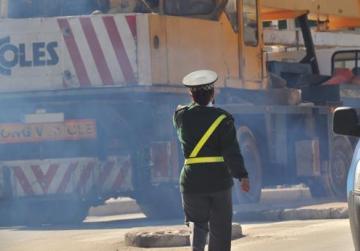
Lower rate than EU of life lost due to particulates
Pollution caused 220 premature deaths in Malta in 2012, according to a study by the European Environment Agency.
While Malta has made substantial progress in cutting air pollution it still exceeded certain limits set by the EU and the World Health Organisation, according to the latest air quality report released by the EU agency.
The report is based on data from 2012 and 2013. During this period Malta’s air monitoring stations registered levels of particulate matter and ozone exposure higher than those permitted by WHO.
The major causes of these two dangerous pollutants are traffic and the building industry.
Particulate matter can cause or aggravate cardiovascular and lung disease, heart attack and arrhythmia. It can also cause cancer.
The report also makes a health impact assessment. It calculates the average number of years of potential life lost (YYL) owing to premature death caused by air pollution.
The measurement takes into account the age at which deaths occur, giving a higher weighting to deaths that occur in a person’s younger years.
In Malta in 2012, 2,300 potential years of life were lost as a result of higher-than-permitted particulate matter levels and another 300 years due to high levels of ozone-related gases in the air, the report estimates.
Malta has a lower YYL rate than the EU average in relation to particulate matter but almost double where it comes to ozone related gases.
On the other hand, the report says that Malta managed to remain within acceptable levels for nitrogen dioxide and sulphur dioxide. These pollutants are linked to combustion and are mainly released by cars, large plants like power stations and heavy industry.
In 2013, Malta reduced its dependence on the aged Marsa power station, with the load shifting to the new BWSC plant in Delimara. Although still operated on heavy fuel oil, the BWSC plant is equipped with air filtering equipment that reduced the level of harmful emissions.
“Malta managed to remain within acceptable levels for pollutants linked to cars”
Car scrappage schemes introduced over the years also helped lower the age of the car fleet as new, cleaner vehicles replaced old ones.
Across the EU, improvements were made in all member states but air pollution is still affecting the general health of Europeans, reducing their quality of life and life expectancy, the report says.
In 2012, particulate matter was responsible for 432,000 premature deaths in Europe while exposure to nitrogen dioxide and ozone gases caused 75,000 and 17,000 premature deaths, respectively.
Bulgaria, Romania and Slovakia were found to have the most pollution in 2012 while Ireland had the cleanest air quality.
Health impacts of air pollution
Air pollutants can have a serious impact on human health.
Children and the elderly are especially vulnerable.
 Graphic: European Environment Agency
Graphic: European Environment AgencyParticulate matter (PM) is particles that are suspended in the air. Sea salt, black carbon, dust and condensed particles from certain chemicals can be classed as a PM pollutant.
Nitrogen dioxide (NO₂) is formed mainly by combustion processes such as those occurring in car engines and power plants.
Ground-level ozone (O₃) is formed by chemical reactions (triggered by sunlight) from pollutants emitted by transport, natural gas extraction, landfills and household chemicals.
Sulphur dioxide (SO₂) is emitted when sulphur-containing fuels are burned for heating, power generation and transport. Volcanoes also emit SO₂ into the atmosphere.
Benzo(a)pyrene (BaP) originates from incomplete combustion of fuels. The main sources include wood and waste burning, coke and steel production and motor vehicle engines.



